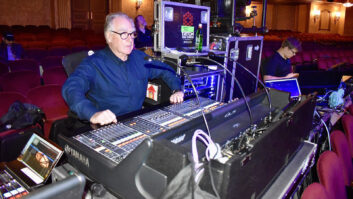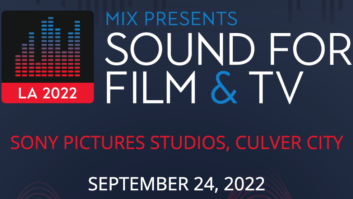A Tim Burton movie would seem on the surface to be a sound editor’s playpen-stylized imagery, dark characters, evocative settings. Whether it’s the scissor effect in Edward Scissorhands or the roar of the Batmobile, there are moments in each of his films that are ripe for sonic experimentation. The key word here is “moments,” because Burton works hand in hand with composer Danny Elfman, and it’s a given that music (albeit, much of it feeling like sound design) is going to be a driving force in his films. For the effects editors and mixers, then, it’s a matter of picking the appropriate spots and cutting through.
“The sounds we’re using so far aren’t quite cliches, but they’re easily identifiable,” explains Skip Lievsay, supervising sound editor and effects re-recording mixer on Sleepy Hollow, Tim Burton’s take on the WashingtonIrving classic. “Most of what we’re doing is really in service of the music track, and Tim [Burton] and Chris [Lebenzon, film editor] have asked that we use kind of Gothic, old-fashioned sounds. I don’t really know what that term means, but to me it brings up a Vincent Price, Hammer horror film in ’50s, ’60s Technicolor-big organ sound.”
It also means, in some cases, picking CD library thunder rather than original recordings, or playing up the sword “swoosh,” all for effect to service the hyper-realistic mood. Thunder and lightning play a prominent role in the soundtrack, as do horse sounds-demonic whinnies and thundering hoofs.
Lievsay has a rather extensive horse library, from work on Wild Wild West and Ride With the Devil, among other films. That was augmented with some original recordings from a breeding farm near Los Angeles. “I think this concept actually goes way back to Dragonslayer,” Lievsay explains, “where Dale Strumpell and Randy Thom went to a breeding farm and got the stallions all excited by taking a mare in heat and parading her around in front of them. They all go insane. We had some of those recordings, and then we sent Dale and Eric Potter out again and got some very good, maniacal stallion sounds. I think they work great, but Tim and Chris are a little concerned that they’re too maniacal.”
Assembling the sound for Sleepy Hollow was truly a bi-coastal effort, with C5 of New York City heading it up on effects and dialog. On the West Coast, Richard Anderson and John Pospisil. of Weddington Productions in North Hollywood contributed special sound design for the climactic windmill scene. Paramount handled the Foley, including horses (hoofbeats, bridle and tack, and leather creaks), with Dan O’Connell of One Step Up in North Hollywood walking all of the Horseman’s horse, as well as the Horseman himself.
“The movie calls for it to be this huge, monster horse, an otherworldly type of animal,” O’Connell says. “The first thing we did was lay down the horse’s feet and get him to sound massive. We really wanted this horse to sound threatening and very powerful. It’s a real beautiful horse, and it looks powerful and thrusting. That’s what we loved about it. Then we went back and laid down a rider-on-saddle track, giving the horse a movement-leather gear with the rider moving against the horse. On top of that we put bridle, and for that horse we did some horse breathing. Then for the rider we did his spurs and his cape, so if the horse is zooming by, you also have the cape fluttering. It added an element that was really nice.”
C5 editors Sean Garnhart and Lewis Goldstein next worked up the horse effects, and Lievsay made separate predubs for horses’ voice, the Horseman’s horse and all the other horses.
“I spent a lot of time beefing up those horse sounds by using reverbs and subs spread across all six channels to give a heightened reality,” Lievsay says. “I have to say, mixing on the [AMS Neve] DFC was great with that because I could automate my EQ moves and, of course, could automate the panning moves. I tried to make every sound follow into the surrounds whenever possible. When we’re riding on the horse, I let the horse sounds play across all six speakers, so it feels like you’re sitting in the saddle. That may read or not, I don’t know, but it certainly has a physical impact.”
The film is set in the foothills of the Catskills, around 1799, so horses and carriages are everywhere in the tracks. But walking out of the theater, audiences will more than likely remember the sounds of the decapitations.
“I don’t think anyone can be fully prepared for the amount of decapitations we have in this movie,” Lievsay says with a dry laugh. “That was the one place where we actually had too much material. The picture department had a whole array of sound effects, which I think they got in England, and that was put meticulously in the temp track. When we first started doing the temps, we had an editor in Los Angeles, Craig Berkey, prepare sword effects for the entire show. Then Dan O’Connell did a whole new set of Foley for the swords, great stuff. In the final we’ve been using a combination of the two-the sound effects and Dan’s Foley.”
“In my travels, I always look for [props],” says O’Connell, who knows a thing or two about sword sounds from his work on 13th Warrior. “I think I was in Manhattan, and I saw this giant sword. All of a sudden you think, ‘Hey, this would be a great movie to use the real ring-y sword.’ It had a real nice ring-off, and it added to the Horseman’s character. The way it played all together, you get the low-end pounding of the horse, his cape flutter, then in the middle the cold-steel shwing-the full spectrum-and that way you get the depth.
“For us, Foley is a matter of getting all the right elements together so that it sounds scary and it sounds real and people buy it,” he continues. “We go from the whoosh of the sword, leading up into the impact, then we do a slice sound, then a ring-off, which is real important because it gives you the full spectrum, from the start of the decapitation to the end of the decapitation. We wanted everything real up-close, everything as it would sound for the person being decapitated. That’s really important, the whoosh coming into the head-definitely hyper-realism.”
Lievsay, who wore dual hats on this film, has been making the transition to re-recording mixer during the past few years while maintaining a foot in supervision. He and a lean crew at C5 began on the film in mid-June, working on the edit for about six weeks, followed by six weeks of mixing. The first five reels of effects and Foley were predubbed at C5’s facility and dumped to Akai MOs, which seem to have become something of a universal exchange format in New York City. Concurrently, Lee Dichter worked up dialog predubs at Sound One in New York City. Lievsay and Frank Morrone then finished up Foley and effects predubs at Todd-AO on the DFC, and Dichter, Lievsay, Morrone, Shawn Murphy and Bobby Fernandez converged in early October for the final. The film underwent a number of edits during this process, ending up on version 17. Because of the way it was dubbed, changes were not a problem.
“I think we have three really big advances that we’re enjoying on this mix,” Lievsay explains. “Number one, we could dub all our units at an early version, knowing that other versions were coming, because the predubs were all to the Akai format, which is in itself an editor. We could easily take the magneto-optical, put it on an Akai editing workstation and do the conform, and in most cases, just by copying and crossfading, we could save the predub without having to fix it on the stage. That’s certainly the case with all the backgrounds and all the sort of more linear sound effects.
“Another great benefit was, on the DFC, we could switch from final dubbing to predubbing in a matter of minutes,” he continues. “Like today, we were finaling reel 4, and at 7 o’clock I said, ‘Okay, you all can go now. We’re going to go into predub mode and fix the problem. We could switch back to predub mode in five minutes and be ready, without having to re-bus and reconfigure and reassign everything. All you have to do is put the target in the recorder and go.
“The third and really kind of the most significant benefit is you could take a predub and make a clone of it, which is basically like an x-copy except that it’s literally the same. Because the console is running digitally, we could dub from x-copy to a new predub without having to worry about losing a generation or having it fuzzing up because of sonic deterioration or any kind of distortion. That is such a major advance-it makes going back and doing fixes a breeze. Like tonight we wanted to fix up a thunder predub, and we wanted to take out some of what we didn’t like and replace it with new. So we put the edited x-copy into a player, and together with new material from Sean’s Pro Tools, we could update the predub in a flash. No running around, no transfer department, no nine guys on the film table conforming units. Our x-copy became the units, and whatever doesn’t work we just patch up on the spot. Big change.”
Sleepy Hollow, a Paramount Pictures release, was scheduled to open the week before Thanksgiving.







